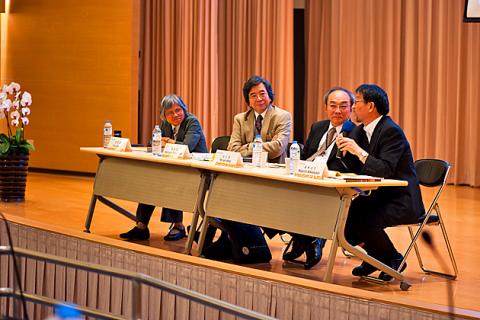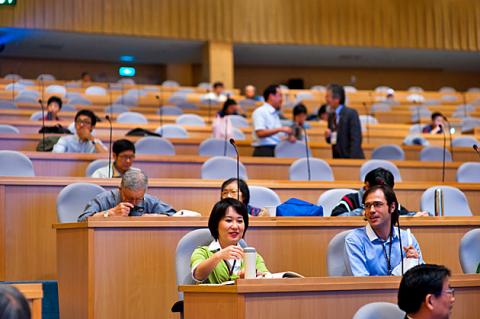Besides being frequently asked what it was like growing up as a foreigner in “China,” a problem I persistently encountered as a graduate student at Columbia University and the London School of Economics, was that the mere mention of Taiwan in conversations about my research to classmates or professors would automatically elicit a response along the lines of: “But are you also going to write about China?”
It was as if Taiwan as an area of study could not exist without China. Consigned to the periphery of studies on “Greater China,” topics such as Taiwanese politics and military affairs were permissible only if they were discussed in relation to China. And I could pretty much forget writing about music, arts or pop culture — some academics who had devoted decades of their lives to advancing the subfield of “Taiwan studies” had no clue who Jay Chou (周杰倫) or Jolin Tsai (蔡依林) were.
The mere thought of devoting a year and a half of my life to researching the history of cross-strait politics or military development was nearly coma-inducing. So in the end, I wrote my 15,000-word dissertation about China. It was on how Soong Mayling (宋美齡, Chiang Kai-shek’s last wife) used her charm, beauty and wits in 1943 to woo American politicians and win support for the Chinese war effort against Japan. Since the Chinese Nationalist Party (KMT) had brought all their documents to Taiwan when they fled China in 1949, this meant I could do most of my research in Taiwan. It was a fair compromise.

Photo courtesy of Dafydd Fell
MORE THAN POLITICS
In the two years since my research, Taiwan studies has made some significant strides. The Second World Congress of Taiwan Studies held at London’s School of Oriental and African Studies (SOAS) and co-organized by Academia Sinica (中央研究院) in Taipei, stands testament to that. The three-day conference starts today and features leading scholars in Taiwan studies from Asia, Europe and North America. Topics covered include not just politics and cross-strait relations but also women’s studies, cinema studies and music.
According to Dafydd Fell, director of the Center of Taiwan Studies at SOAS, the inaugural conference held at Academia Sinica three years ago was “very large and a little extravagant.”

Photo courtesy of Academia Sinica
This time, to make the conference more international and inclusive, organizers invited younger scholars, expanded the range of topics and planned more roundtable discussions. The conference will also include musical performances as well as a film screening, two non-political areas that tend to attract much interest in Taiwan, Fell says.
“In fact, one of the great things about being in the Taiwan studies field is, as a political scientist, I get exposed to issues related to Taiwanese popular culture,” he added.
Another topic that will be covered at the conference is linguistics. Keynote speaker and Academia Sinica research fellow Paul Li (李壬癸) will be presenting some of his research on Aboriginal languages — a field of study that has been growing in popularity over the last 20 years since the KMT lifted its ban on learning languages other than Mandarin.

Photo courtesy of Academia Sinica
“Looking back at the history of Taiwan starting from centuries ago, Taiwan was more connected to the Pacific islands and Southeast Asia than China,” Li says, referring to how Aboriginal languages can be traced back to Austronesian languages.
He sees Aboriginal languages, and by extension, culture, as being part and parcel of a larger Taiwanese culture, differentiating Taiwan from China.
CHINA’S RELATION TO TAIWAN STUDIES

Photo courtesy of Academia Sinica
Yet, most academics researching Taiwan still have a compelling need to bring China into the discussion. When asked whether or not Taiwan studies could be taught as an entity in and of itself without the constant need to situate it within the context of “Greater China,” Fell says that growing interest in China has actually benefited Taiwan scholars — something which I hadn’t considered before.
Fell says that we must understand that there are generally two types of academics who pursue Taiwan Studies. One group — himself included — are in disciplinary departments. This means they must teach social science courses that often focus on East Asia as a whole. The second group, which consist of those in China studies departments, need to teach China courses but will devote their research to Taiwan.
“The expansion in China studies jobs created opportunities for academics that research Taiwan,” Fell says.
He adds that he believes Taiwan studies, at least in Europe, “has never been as healthy as today.”
REVIVAL OF THE FIELD?
Murray Rubinstein, a senior research scholar at Columbia University and one of the conference’s keynote speakers, agrees with Fell. In the US however, he says, Taiwan Studies is still a “small subfield,” and even smaller when it comes to studying pop culture, with Marc Moskowitz at the University of South Carolina as one of the few experts in that particular niche.
Since giving his keynote address, “Is Taiwan Studies Dead?” at a European Association of Taiwan Studies conference in Madrid in 2009, Rubinstein’s views have become slightly more optimistic. He cites Fell’s Taiwan program at SOAS as an example of growth in the field. In the US, Rubinstein’s seminar/lecture series on Taiwan at Columbia University which he developed and taught in 2011 along with Myron Cohen, a professor of anthropology, is another positive example. The course was taught again during the spring semester of this year.
Part of the reason why Rubinstein had posed the hypothetical question was because he noticed that a number of Taiwan specialists were shifting their focus to China — including Stevan Harrell from the University of Washington and the late Norma Diamond from the University of Michigan in Ann Arbor — although he adds that this started back when the US resumed diplomatic ties with China after the death of Mao Zedong (毛澤東).
“Those who studied Taiwan before 1979 found they could study similar topics in China,” Rubinstein says.
Fell and Rubinstein both agree that recent government funding, most notably from the Ministry of Foreign Affairs and the Ministry of Education, but also from non-profit foundations like the Chiang Ching-kuo Foundation for International Scholarly Exchange (蔣經國國際學術交流基金會), is one of the main reasons that academics are able to pursue more research on Taiwan nowadays.
“A key reason the SOAS Taiwan program has been so successful is long-term funding,” Fell says.
“What makes Taiwan studies more possible now is the help that the government of Taiwan has begun to give to schools to develop various programs and courses,” Rubenstein adds.
Like the chicken-or-egg question, it’s hard to tell whether academics have always been interested in Taiwan and are now receiving more funding, or if increased funding is helping generate more scholarly interest in Taiwan.
Either way, Taiwan studies is not dead. And, as the conference shows, there are plenty of topics worth studying other than cross-strait relations or politics. Maybe graduate students in the future won’t be as afraid to branch out.

Many people noticed the flood of pro-China propaganda across a number of venues in recent weeks that looks like a coordinated assault on US Taiwan policy. It does look like an effort intended to influence the US before the meeting between US President Donald Trump and Chinese dictator Xi Jinping (習近平) over the weekend. Jennifer Kavanagh’s piece in the New York Times in September appears to be the opening strike of the current campaign. She followed up last week in the Lowy Interpreter, blaming the US for causing the PRC to escalate in the Philippines and Taiwan, saying that as

Nov. 3 to Nov. 9 In 1925, 18-year-old Huang Chin-chuan (黃金川) penned the following words: “When will the day of women’s equal rights arrive, so that my talents won’t drift away in the eastern stream?” These were the closing lines to her poem “Female Student” (女學生), which expressed her unwillingness to be confined to traditional female roles and her desire to study and explore the world. Born to a wealthy family on Nov. 5, 1907, Huang was able to study in Japan — a rare privilege for women in her time — and even made a name for herself in the

This year’s Miss Universe in Thailand has been marred by ugly drama, with allegations of an insult to a beauty queen’s intellect, a walkout by pageant contestants and a tearful tantrum by the host. More than 120 women from across the world have gathered in Thailand, vying to be crowned Miss Universe in a contest considered one of the “big four” of global beauty pageants. But the runup has been dominated by the off-stage antics of the coiffed contestants and their Thai hosts, escalating into a feminist firestorm drawing the attention of Mexico’s president. On Tuesday, Mexican delegate Fatima Bosch staged a

Would you eat lab-grown chocolate? I requested a sample from California Cultured, a Sacramento-based company. Its chocolate, not yet commercially available, is made with techniques that have previously been used to synthesize other bioactive products like certain plant-derived pharmaceuticals for commercial sale. A few days later, it arrives. The morsel, barely bigger than a coffee bean, is supposed to be the flavor equivalent of a 70 percent to 80 percent dark chocolate. I tear open its sealed packet and a chocolatey aroma escapes — so far, so good. I pop it in my mouth. Slightly waxy and distinctly bitter, it boasts those bright,